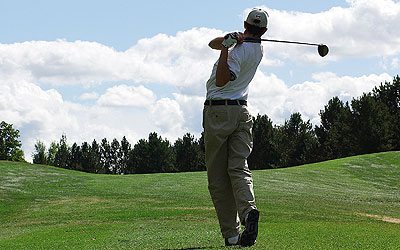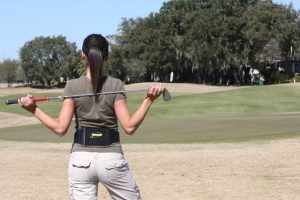Spring has finally sprung and across the country men women and children of all ages are heading back out for a relaxing day at the golf course. Golf is a great sport for people of all ages, fun for kids, challenging for adults and a firm favorite with many older people.
Perhaps because golf takes place in such a calm, relaxed environment we can often forget the like any sport, there are some hazards and injuries can occur if you don’t take the proper precautions. Golf can be especially hard on the spine, often triggering back problems – so this week, let’s take a quick look at how to protect your spine when out on the course.
Proper posture prevents poor performance!
Proper posture -both on and off the course – is key to avoiding golf related injuries and improving your game.
If you’ve ever taken golf lessons, you’ll know that your instructor spends much of their time tweaking and adjusting your posture to give you the best swing possible. For instance, a level back swing is almost totally dependent dent on proper posture. Furthermore, any gold swing relies on the ability of the spine to twist and rotate in a natural way without impingement – That’s why a healthy spine is so vital to a golfer’s game. If the spine is out of alignment, the swing will also be out of alignment.
Its not surprise that many of our clients are golfers! Your regular adjustment could literally take points off your game!
Try walking the course
Like any sport, golf requires a level of fitness – the fitter you are, the better your body will hold up against the stress of the game. Want to get an extra fitness boost out of your game – Choose to walk the course, rather than rent a cart. Walking will help to keep your muscles warm and supple and will improve aerobic fitness over time. Cant walk the whole course? Grab the cart, but try walking to every other hole – take turns with your partner to drive and walk.
Don’t blame your gear… except your bag
It’s a poor carpenter who blames his tools – but every now and then the tool is actually at fault! Although golfers tend to blame back related problems on suboptimal swings (and that’s a fair assumption) many golf-related injuries have nothing to do with the actual game – the biggest cause outside the swing? Golf bags.
Golf bags, by themselves, have substantial bulk and weight. Add to that the maxim um number of clubs allowed during course play -a mix of 14 irons and woods – along with a dozen or so balls and assorted accessories. The result? Enough weight to cause serious injury. Ironically, if you’re walking the course to improve your fitness, a poorly selected bag actually makes injury more likely!
To avoid the risk, choose a bag which has been designed to better load the spine, or invest in a reliable trolley. Even then, ask your chiropractor for some advice on lifting a golf bag – its size and weight makes injury easy.
Watch your back
Lower back injuries are perhaps the most common problem for golfers. Lower back pain is often caused by, or aggravated by golf – and that’s a problem, since a huge number of us suffer with lower back pain.
But why is golf so bad for your lower back? According to researchers , the answer is two-fold: poor mechanics and today ‘s more demanding swing. The problem isn’t always just spinal alignment either – Stiff hip and back muscles are often the root causes of flawed mechanics. Also, older golfers may have back conditions that the swing aggravates: The disks between the spinal vertebrae get less elastic with the years and, therefore, are less able to distribute the stresses that the swing puts on the back.[1]
Fortunately, these are exactly the kinds of problems that Chiropractic care is ideally suited to address, and many golfers know it. All the way back in 1994 in the U.S. (a nation with more golfers than any other) Agency for Health Care Policy and Research and the Department of Health and Human Services endorsed chiropractic adjustments as an effective treatment for acute low-back pain (LBP) in adults.
Have a warm up! (No, really – have a warm up!)
Golf is a sport, so treat it like a sport! Warming up is essential when it comes to staying in the game. However, despite overwhelming evidence supporting the need to warm up, most golfers remain cold to the idea. This is a real problem which has been recognised by the PGA for quite some time:
“Few amateur players adequately warm up before practicing or playing a round of golf. If you don’t stretch prior to golfing, you are asking your body to play golf with an added handicap. Muscles that are warm and stretched properly prior to teeing off are supple and loose, which enables your body to perform to its full potential.” Notes a core trading manual. [2]
In one three-week study conducted at a private club, public course and golf driving range in Australia researchers observed 1,040 amateur golfers (852 men and 188 women) over the age of 18. Shockingly, only 54.3 percent performed some form of warm up activity. Air swings on the tee were the most conmanly observed warm up activity, with 88.7 percent of golfers who did a warm up opted for these.[3] Air swings are better than nothing – but they are far from ideal as a warm up for an entire round of golf.
An ideal stretching routine needs to take into account all the muscle groups which will be relied upon during the coming sporting activity – for golf this means you actually need to focus on stretching out the vast majority of your muscles, and especially need to concentrate on warming up your back.
At complete chiropractic, we think that may golfers don’t do a proper warm up because they’ve never had specific advice on how to do this – just ask Dr Irvine at your next adjustment and we can give you an easy to perform spine protective warm up routine, ideal for golfers.
Consider shortening your swing
One study shows that shortening the backswing may reduce trunk muscle activation and possibly prevent back injury and pain – without affecting swing accuracy or club-head velocity . However, there is also some evidence that this technique might pose more of a risk for the shoulder – think carefully about how to adjust your game to best avoid any trouble spots you might have.[4]
Treat injuries with respect
Most footballers, rugby players or track athletes know what an injury feels like, and know when to stop. Granted, the threshold at which you throw in the towel for the day depends on your sport – but golfers are notorious for ignoring injury warning signs all together.
If you are experiencing pain, just stop! Pain is your body’s way of letting you know that there is a problem. Go one better for yourself and take some preventative action right away. Strained your back on the course? Don’t just “play through” and ignore the pain – and especially don’t limo through the week with a bad back and then go back to the course next weekend! Give us a call and drop in for a check up and adjustment. Often this is all that’s required to prevent a small injury becoming a big injury.
Golfers love chiropractic
These are just some of the reasons that golfers love chiropractic care – watch out for some tips on how chiropractic care can help you take your game to the next level next week! In the mean time, why not schedule an appointment for a pre-game adjustment, of if you’ve never tried chiropractic take advantage of our new patient special offer!
[1] Harvard Health letter 2000;25
[2] PGA Tour Golf Academy Student Instruction Manual 2002: 121
[3] Br J Sports Med 2001;35: 125- 7
[4] J Manipulative Physiol Ther 200 I;24:569-75

